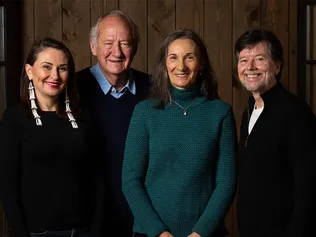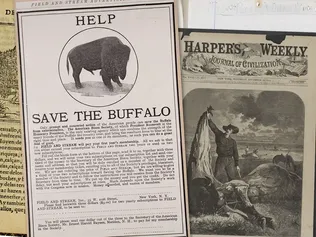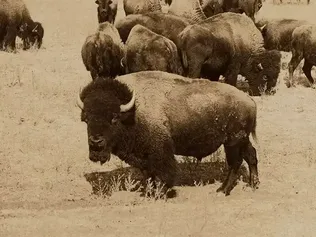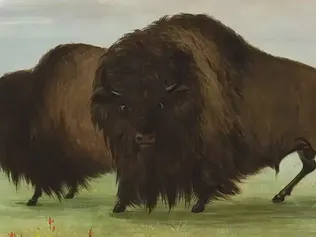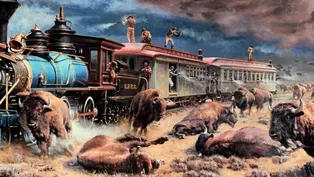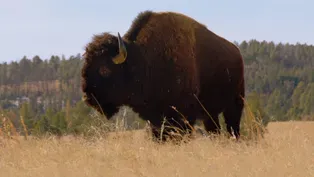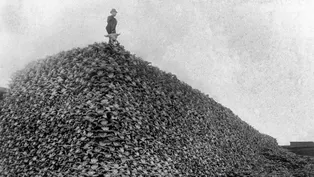
A Legacy of Broken Promises
Clip: 10/16/2023 | 10m 24sVideo has Closed Captions
The U.S. government made treaties with Indigenous people when it was convenient.
The U.S. government made treaties with Indigenous people when it was convenient, and broke these treaties when it was inconvenient. This recurring pattern made it increasingly difficult for Native people to live – and survive – as they once had.
Corporate funding for The American Buffalo was provided by Bank of America. Major funding was provided by the Corporation for Public Broadcasting, and by The Better Angels Society and its...

A Legacy of Broken Promises
Clip: 10/16/2023 | 10m 24sVideo has Closed Captions
The U.S. government made treaties with Indigenous people when it was convenient, and broke these treaties when it was inconvenient. This recurring pattern made it increasingly difficult for Native people to live – and survive – as they once had.
How to Watch The American Buffalo
The American Buffalo is available to stream on pbs.org and the free PBS App, available on iPhone, Apple TV, Android TV, Android smartphones, Amazon Fire TV, Amazon Fire Tablet, Roku, Samsung Smart TV, and Vizio.
Buy Now
Providing Support for PBS.org
Learn Moreabout PBS online sponsorshipThe U.S. government made treaties with the Indians when they wanted something and it was convenient.
And the second that the treaty was inconvenient and they wanted something else, they broke the treaty.
And that pattern permeates the history of the United States government with Indigenous peoples.
["Northwest Territory" by Tony Ellis playing] Narrator: In 1874, things got worse.
Lieutenant Colonel George Armstrong Custer led an expedition into the Black Hills, an area considered sacred by the Lakota and reserved exclusively for them by treaty.
A prospector Custer brought along started searching for gold there.
Meanwhile, farther south, hide hunters continued to cross the Arkansas River into the buffalo range supposedly off-limits to whites and brazenly established outposts to keep themselves supplied with ammunition and whatever else they needed to continue their deadly business.
Man: "Your people make big talk "and sometimes make war if an Indian kills "a white man's ox to keep his wife "and children from starving.
"What do you think my people ought to do "when they see their cattle-- the buffalo-- killed by your race when they are not hungry?"
Little Robe.
[Flash bulb pops] Man as Mayer: "The Indians sensed that we were "taking away their birthright "and that with every boom of a buffalo rifle, "their tenure on their homeland became weakened, "and that eventually, they would have "no homeland and no buffalo.
"So they did what you and I would do "if our existence were jeopardized: they fought."
Frank Mayer.
Narrator: Incensed by the treaty violations in the southern and northern Plains, warriors from the Lakota, Cheyenne, Arapahoe, Kiowa, and Comanche struck back, raiding stagecoaches, wagon trains, and homesteads.
Among the Quahada band of Comanches was a tall 26-year-old, who was already rising in leadership, named Quanah.
He had been born near the sacred Wichita Mountains, the oldest son of a prominent chief and a white woman, Cynthia Ann Parker, who had been taken captive as a child and adopted into the Comanche tribe.
[Gunfire] In 1860, while Quanah and his father and most of the other warriors were gone, Texas Rangers overran their village, killed a number of people, and took his mother and baby sister into custody.
Man: It was a massacre, but it wasn't a famous thing you read about in Texas history.
They eventually took her back to her--her people, but she didn't want to go.
She never wanted to go back because she was Comanche.
Narrator: Cynthia tried several times to rejoin the Comanches without success.
She lost her young daughter to pneumonia.
Unable to live among her people, Cynthia died in despair.
Her son Quanah had already distinguished himself with his fearless courage, leading attacks on Texans, against whom he harbored an implacable hatred for kidnapping his mother and sister.
He had attended the Medicine Lodge Treaty negotiations, which the Quahadas had adamantly refused to sign.
For seven years, they had stayed away from the reservation, and Quanah took part in skirmishes with the soldiers sent to force them in.
Now, at the yearly Sun Dance, a war against the hide hunters was being planned.
Man: Quanah knew that they had to destroy the buffalo hunters.
It becomes a matter of defense, of defending your people, of defending your family, of defending the buffalo.
Narrator: A Comanche medicine man named Isatai announced that in a vision, he had been given special powers to help the tribes retake their homelands and restore the old ways.
Man: "Isatai was making big talk at that time.
"He says, 'God told me "'we are going to kill lots of white men.
"'I will stop the bullets in their guns.
"'Bullets will not pierce our shirts.
We will kill them all.'"
Quanah.
[Melody by Bobby Horton playing] Narrator: With Quanah and Isatai leading, more than 300 Comanche, Kiowa, and Cheyenne set off for Adobe Walls, a trading post in the Texas Panhandle servicing the buffalo hunters who were trespassing.
[Galloping hoofbeats] Twenty-nine people were there when the Indians attacked at dawn on June 27, 1874.
Two white men were killed in the early moments, as hide hunters who had been sleeping under their wagons scrambled to defend themselves before taking shelter in the buildings.
Billy Dixon helped drive off the attack.
[Door slams] Man as Dixon: For the first half-hour, the Indians were reckless and daring enough to ride up and strike the doors with the butts of their guns.
[Gunfire] Finally, the buffalo hunters all got straightened out and were firing with deadly effect.
The Indians stood up against this for a while, but gradually began falling back, as we were emptying rawhide saddles entirely too fast for Indian safety.
Narrator: Seeing a group of Indians on a bluff more than 3/4 of a mile away, the hunters urged Dixon to take a shot with his big Sharps buffalo rifle.
"I took careful aim and pulled the trigger," he said.
"We saw an Indian fall from his horse."
The bullet had struck before the rider heard the sound of Dixon's rifle.
[Galloping hoofbeats] Fifteen warriors had died in the initial attack.
Quanah was wounded, but kept fighting.
"All the Cheyennes were very mad at Isatai," Quanah remembered.
They shouted, "What's the matter with your medicine?"
One Cheyenne beat him with a riding whip.
["Full Moon Insomnia" by Randy Granger playing] Narrator: After the battle of Adobe Walls, Comanche, Kiowa, Cheyenne, and Arapaho warriors regrouped and embarked on new raids across Texas, Colorado, and parts of New Mexico and Kansas that left 190 white people dead.
President Grant put the reservations under military control.
Any Indians who did not return were to be considered "hostile" and hunted down.
On the morning of September 28, 1874, Colonel Ranald S. Mackenzie and 13 companies of cavalry and infantry reached the rim of Palo Duro Canyon in the Texas Panhandle.
Peering down, he saw an array of encampments spread along the canyon floor.
He ordered his men down a narrow trail, and they began their charge.
[Men shouting] The villagers fled up the canyon walls, while warriors covered their retreat.
Duncan: Not many people died in the battle of Palo Duro Canyon, but what Mackenzie was able to do was they had left their tepees, their winter food supplies, and their horse herd, and he gathered up the food supplies and the tepees, set them on fire.
[Horses whinnying] Flores: Then, he takes this pony herd of 1,450 horses.
He lets his Indian auxiliaries have the pick of about 150 of those horses, and then he has his forces shoot down all the remaining animals.
It was kind of a scorched-earth strategy: "I'm not going to keep these horses.
We're just gonna kill 'em."
We have elders today who say that if you go to that site that you can still hear-- you can still hear those horses and the destruction and the--and the crying that went forth, um, so long ago.
["Comanche Riding Song," by Randy Granger playing] Narrator: For the rest of the fall and into the winter, the army's columns patrolled the Panhandle, ceaselessly pursuing any straggling bands who didn't return to the reservation.
Many of them, reduced to eating roots and rodents to survive, began to starve.
In February of 1875, the last of the Kiowas came in to the reservation at Fort Sill, Oklahoma, then the Cheyenne in March, followed by some Comanches.
By May, only Quanah and his 400 Quahadas-- who still had some horses-- remained free.
Tahmahkera: It's said that Quanah went up on a hill and drew a buffalo robe over his head and was waiting for signs, for direction.
It's said that a wolf came along and howled and took off in the direction of Fort Sill.
It's said that an eagle flew overhead and began flying in the direction of Fort Sill.
Quanah took those as signs to finally go to Fort Sill with the other Quahadas.
Industrial Expansion West and Its Impact
Video has Closed Captions
After the Civil War, Americans set out with renewed energy to unite the East and West. (8m 52s)
Surprising Facts About the Buffalo
Video has Closed Captions
Did you know a buffalo can clear a six-foot fence? (9m 40s)
Why Is Destruction Part of Our Story?
Video has Closed Captions
The scale of wild animal loss during the 1800s is the largest in known human history. (9m 59s)
Providing Support for PBS.org
Learn Moreabout PBS online sponsorshipCorporate funding for The American Buffalo was provided by Bank of America. Major funding was provided by the Corporation for Public Broadcasting, and by The Better Angels Society and its...

